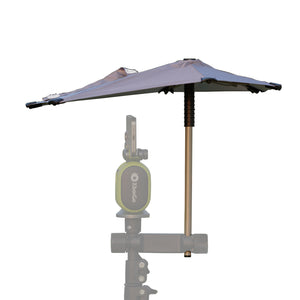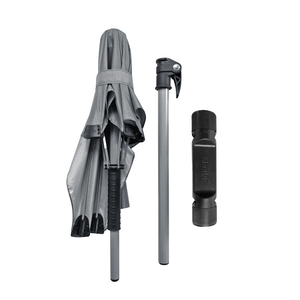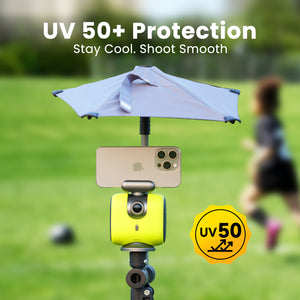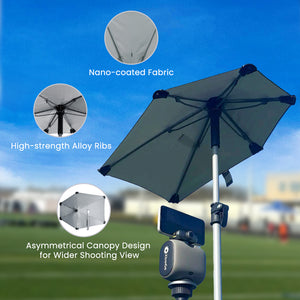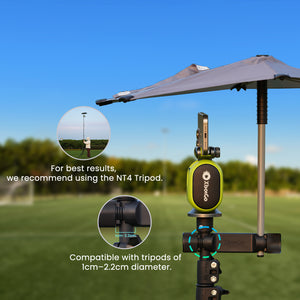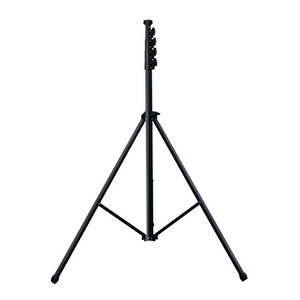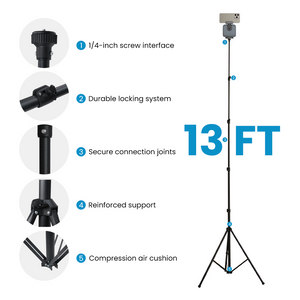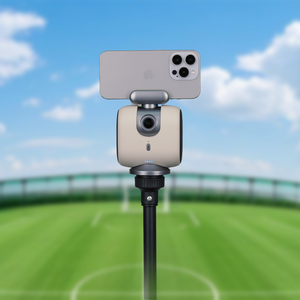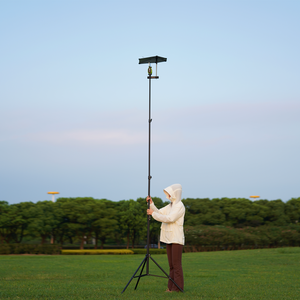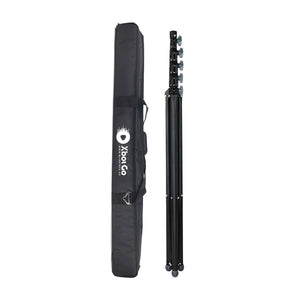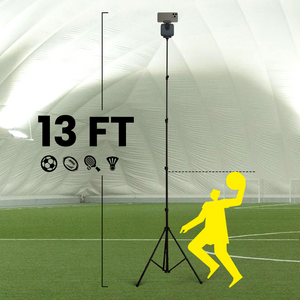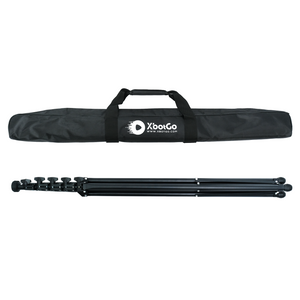XbotGo Chameleon AI Sports Camera
Wie lange dauert ein Hockeyspiel? Der vollständige Leitfaden
Eishockey ist dank seiner rasanten Action und knallharten Checks eine der spannendsten Sportarten überhaupt. Wer ein Spiel besuchen oder sich die Zeit zum Zuschauen einplanen möchte, fragt sich sicher, wie lange das Ganze dauern wird. Die überraschende Wahrheit: Obwohl die offizielle Spielzeit 60 Minuten anzeigt, sind es tatsächlich 2,5 bis 3 Stunden . Fernsehsender kalkulieren für NHL-Übertragungen 2 Stunden und 45 Minuten ein , und diese zusätzliche Zeit ist für jeden Eishockeyfan aus gutem Grund wichtig.
Egal, ob Sie Ihr erstes NHL-Spiel besuchen, das Jugendhockeyspiel Ihres Kindes anschauen oder eine College-Hockey-Party planen – dieser Leitfaden erklärt Ihnen genau, was Sie erwartet und wie Sie entsprechend planen können.
Die Realität vs. die Uhr
Offizieller vs. Echtzeit
Ein typisches Eishockeyspiel besteht aus drei Dritteln à 20 Minuten, was insgesamt 60 Minuten offizieller Spielzeit ergibt . Ganz einfach, oder? Nicht ganz.
Tatsächlich dehnt sich ein Drittel in der Regel deutlich länger aus. Jedes Drittel dauert aufgrund von Unterbrechungen durch Strafen, Tore, Icing und Puckaus-Situationen typischerweise 35 bis 40 Minuten. Die Spieluhr wird jedes Mal angehalten, wenn der Schiedsrichter pfeift, was viel häufiger vorkommt, als Neulinge erwarten.
Zwischen den Dritteln gibt es zwei Pausen von jeweils 15 bis 20 Minuten (17 Minuten sind Standard bei NHL-Spielen). Diese Pausen dienen der Eisaufbereitung, der Erholung der Spieler und – natürlich – den Werbeunterbrechungen, die den Ligen finanzielle Stabilität sichern.
Warum Spiele länger dauern
Mehrere Faktoren verwandeln dieses kompakte 60-Minuten-Paket in ein komplettes Abendprogramm:
Spielunterbrechungen : Jeder Pfiff stoppt die Uhr. Ob Strafe, Abseits oder ein Puck, der ins Publikum fliegt – diese Unterbrechungen kosten wertvolle Zeit. In Überzahlspielen, wenn ein Team aufgrund gegnerischer Strafen mehr Spieler auf dem Eis hat, kommt es häufig zu mehr Unterbrechungen, da die Teams ihre Strategien anpassen müssen.
Werbeunterbrechungen : NHL-Spiele beinhalten vorgeschriebene TV-Auszeiten – drei pro Drittel in der regulären Saison. Diese erfolgen nach der ersten Unterbrechung nach 14:00, 10:00 und 6:00 Minuten jedes Drittels und verlängern die Spielzeit um etwa 2 Minuten.
Videoüberprüfung : Im modernen Eishockey gibt es Videoüberprüfungen bei Toren, Abseitsentscheidungen und anderen wichtigen Spielsituationen. Diese gewährleisten zwar Fairness, können aber die Spielzeit um einige Minuten verlängern.
Verletzungen und Ausrüstungsprobleme : Bei Verletzungen von Spielern oder Ausrüstungsausfällen wird die Spieluhr angehalten, bis die Probleme behoben sind. Diese unerwarteten Verzögerungen können zwischen 30 Sekunden und mehreren Minuten dauern.
Die "Stunde pro Periode"-Regel
Erfahrene Eishockeyfans schwören auf eine einfache Planungsstrategie: eine Stunde pro Drittel einplanen. Diese Faustregel berücksichtigt Folgendes:
- 20 Minuten Spielzeit
- 15-20 Minuten Unterbrechungen und Spielstillstände
- 17-20 Minuten bis zur folgenden Pause
Diese Kopfrechnung hilft Ihnen, das Spielende genauer vorherzusagen. Bei einem Spielbeginn um 19:00 Uhr können Sie davon ausgehen, dass Sie gegen 21:30-22:00 Uhr wieder zu Hause sind.
Dauer nach Hockey-Niveau
NHL-Profispiele
NHL-Spiele folgen dem standardisiertesten Format und dauern in der Regel 2,5 bis 3 Stunden vom Puckeinwurf bis zum Schlusspfiff. Hier die Aufschlüsselung:
- Regelzeit : 60 Minuten (3 × 20-Minuten-Abschnitte)
- Pausen : Zwei 17-minütige Pausen
- Typische Gesamtdauer : 2 Stunden 30 Minuten bis 2 Stunden 45 Minuten
Geht das Spiel in die Verlängerung, kommen weitere 10–15 Minuten für die 5-minütige Sudden-Death-Phase und ein mögliches Penaltyschießen hinzu. Playoff-Spiele können deutlich länger dauern, da sie mit 20-minütigen Sudden-Death-Phasen fortgesetzt werden, bis ein Tor fällt – Penaltyschießen ist hier nicht erlaubt.
Dauer des College-Eishockeys
College-Eishockey ähnelt in seiner Struktur der NHL, die Spielzeiten sind aber oft etwas kürzer:
- Spieldauer : Gleiches 60-Minuten-Format
- Pausen : Üblicherweise 15 Minuten (kürzer als in der NHL)
- Werbeunterbrechungen : Weniger häufig und kürzer als bei Profispielen
- Übliche Gesamtdauer : 2 bis 2,5 Stunden
Die Atmosphäre mag genauso intensiv sein, aber da es weniger Werbeunterbrechungen gibt, verlaufen College-Spiele tendenziell schneller.
Jugendhockey-Varianten
Die Dauer des Jugendhockeys variiert je nach Altersgruppe dramatisch, wie umfangreiche Untersuchungen im Gemeinwesen ergaben:
Milben (5-6 Jahre) :
- 30 Minuten Laufzeit
- Summer ertönt alle 3 Minuten für Linienwechsel
- Gesamtzeit: 45-60 Minuten
Squirts (9-10 Jahre) :
- Drei 12-Minuten-Abschnitte
- Laufzeit oder Stoppzeit, je nach Liga
- Gesamtzeit: 50-70 Minuten
Peewees (11-12 Jahre) :
- Drei 15-minütige Stoppzeitperioden
- Gesamtzeit: 1,5 Stunden
Bantams und Midgets (13-18 Jahre) :
- Drei vollständige 20-minütige Stoppzeitperioden
- Gesamtzeit: 2-2,5 Stunden
Diese Abfolge hilft jungen Spielern, Ausdauer aufzubauen und gleichzeitig altersgerechte Spiele zu gewährleisten.
Internationales und Feldhockey
Internationales Eishockey orientiert sich im Allgemeinen an den Zeitvorgaben der NHL, aber beim Feldhockey sieht die Sache anders aus:
- Internationales Eishockey : 60 Minuten (3 x 20 Minuten)
- Feldhockey : Kürzlich geändert von 70 Minuten (2×35 Minuten Halbzeiten) auf 60 Minuten (4×15 Minuten Viertel)
- Olympisches Eishockey : Entspricht den internationalen Eishockeystandards.
Diese Variationen spiegeln unterschiedliche Sporttraditionen und Übertragungsbedürfnisse weltweit wider.
Faktoren, die die Spielzeit verlängern
Verlängerung und Elfmeterschießen
Endet die reguläre Spielzeit unentschieden, geht das Spiel in die Verlängerung – deren Ablauf jedoch von der Spielsituation abhängt:
Verlängerung in der regulären Saison :
- 5-minütige Sudden-Death-Phase (3-gegen-3-Format)
- Bei Gleichstand kommt es zum Elfmeterschießen.
- Zusätzliche Zeit: 10-20 Minuten
Playoff-Verlängerung :
- 20-minütige Sudden-Death-Phasen (5-gegen-5-Format)
- Das Spiel geht so lange weiter, bis jemand ein Tor erzielt.
- Kann die Spielzeit um Stunden verlängern
Das längste NHL-Spiel der modernen Geschichte fand im Jahr 2000 zwischen den Philadelphia Flyers und den Pittsburgh Penguins statt und ging über fünf Verlängerungen – das sind 92 zusätzliche Minuten Eishockey nach der regulären Spielzeit!
Spielablaufelemente
Mehrere spielinterne Faktoren beeinflussen die Spieldauer erheblich:
Strafen : Kleine Strafen (2 Minuten) und große Strafen (5 Minuten) führen zu Überzahlsituationen. In diesen Phasen wird das Spiel häufiger unterbrochen, da sich die Teams neu formieren müssen. Ein Spiel mit vielen Strafen kann die Gesamtspielzeit leicht um 15 bis 20 Minuten verlängern.
Schlägereien : Obwohl sie heutzutage seltener vorkommen, unterbrechen Schlägereien das Spiel vollständig. Die Auseinandersetzung, die Beratung mit dem Schiedsrichter und die Verhängung einer Strafe können die Spielzeit um 5 bis 10 Minuten verlängern.
Verletzungen : Verletzungen von Spielern erfordern sofortige Behandlung. Schwere Verletzungen können die Wartezeit um mehr als 10 Minuten verlängern, während das medizinische Personal die Sicherheit der Spieler gewährleistet.
Ausrüstungsmängel : Kaputte Schläger, beschädigte Banden oder Probleme mit der Torwartausrüstung unterbrechen die Spieluhr. Einzelne Vorfälle sind zwar kurz, summieren sich aber im Laufe eines Spiels.
Auswirkungen des Rundfunks
Das Fernsehen hat einen erheblichen Einfluss auf die Spieldauer durch:
- Geplante Werbeunterbrechungen : Drei pro Werbeperiode zu festgelegten Zeiten
- Verlängerte Spielpausen : Die Fernseh-Spielpausen dauern 17–20 Minuten, im Vergleich zu 15 Minuten bei nicht im Fernsehen übertragenen Spielen.
- Zeremonien vor dem Spiel : Nationalhymnen, besondere Ehrungen und Spielervorstellung
- Verzögerungen nach dem Pfiff : Fernsehsender benötigen manchmal zusätzliche Sekunden, um Wiederholungssequenzen fertigzustellen.
Diese Übertragungsvorschriften verlängern das Live-Spielerlebnis im Vergleich zu nicht im Fernsehen übertragenen Spielen um etwa 20-30 Minuten.
Planung Ihres Hockey-Erlebnisses
Anwesenheitsplanung
Rechtzeitiges Erscheinen verbessert Ihr Spielerlebnis. Dauerkarteninhaber empfehlen:
Ankunftszeit : Bitte seien Sie 30–45 Minuten vor Spielbeginn in der Arena. So bleibt genügend Zeit für Folgendes:
- Parken und Sicherheit
- Finden Sie Ihre Sitzplätze
- Aufwärmübungen beobachten (für Anfänger sehr empfehlenswert)
- Sich Snacks und Getränke holen, ohne das Spielgeschehen zu verpassen
Tatsächlicher Spielbeginn : Ungeachtet der veröffentlichten Startzeiten erfolgt der Spielbeginn in der Regel 10–15 Minuten später. Eine Startzeit von 19:00 Uhr bedeutet üblicherweise einen Spielbeginn zwischen 19:10 und 19:15 Uhr nach den Durchsagen und der Nationalhymne.
Verwaltung des Besichtigungsplans
Für das Fernsehen oder Streaming sollten Sie folgende Pufferstrategien implementieren:
- Spiele der regulären Saison : 3 Stunden einplanen
- Playoff-Spiele : Planen Sie mindestens 3,5 Stunden ein (Verlängerung ist üblich).
- Spielaufzeichnung : 30–60 Minuten zur Standardaufnahmezeit hinzufügen.
Viele Fans orientieren sich bei ihrer Spielplanung an der Regel „eine Stunde pro Spielabschnitt“. Dieses Denkmodell erweist sich selten als unbrauchbar.
Historischer und moderner Kontext
Wie sich die Spieldauer entwickelt hat
Die Spieldauer im Eishockey war nicht immer standardisiert. Wichtige Meilensteine sind:
Vor 1910 : Die Spiele bestanden aus zwei 30-minütigen Hälften.
1910–1927 : Drei 20-Minuten-Stunden wurden Standard.
1942–1983 : Keine Verlängerung in der regulären Saison (Spiele konnten unentschieden enden)
1983 bis heute : 5-minütige Verlängerung in der regulären Saison eingeführt
2005 bis heute : Elfmeterschießen nach Verlängerung eingeführt
2015–heute : Einführung des 3-gegen-3-Verlängerungsformats
Diese Änderungen spiegeln die Entwicklung des Sports hin zu spannenderen Schlussphasen wider, wobei gleichzeitig angemessene Zeitvorgaben für Sender und Fans gewahrt bleiben.
Die längsten Spiele der Geschichte
Die Marathonspiele im Eishockey verdeutlichen die unglaublichen Ausdaueranforderungen dieses Sports:
- Detroit Red Wings gegen Montreal Maroons (1936) : 176 Minuten, 30 Sekunden – fast drei komplette Eishockeyspiele.
- Maple Leafs gegen Bruins (1933) : 164 Minuten, 46 Sekunden
- Philadelphia Flyers gegen Pittsburgh Penguins (2000) : 152 Minuten, 1 Sekunde – das längste Spiel der modernen Geschichte
Diese epischen Schlachten erinnern uns daran, dass wir zwar die Spieldauer abschätzen können, aber das Sudden-Death-Overtime-Format im Eishockey bedeutet, dass alles möglich ist.
Modernes Rundfunkzeitalter
Die heutige Spieldauer spiegelt die Realitäten der modernen Fernsehübertragung wider:
- Konsistente Terminplanung : Netzwerke benötigen planbare Zeitfenster.
- Erweiterte Analyse : Zwischenperiodensegmente mit Expertenkommentaren
- Digitale Integration : Highlights aus sozialen Medien und Echtzeitstatistiken
- Internationales Publikum : Planungsüberlegungen für internationale Zuschauer
Diese Faktoren haben zu einer Standardisierung der Spielpräsentation geführt, während der einzigartige Spielfluss und die Spannung des Eishockeys erhalten blieben.
Abschluss
Wenn Sie die Spieldauer eines Eishockeyspiels kennen, können Sie das perfekte Zuschauererlebnis planen. Merken Sie sich Folgendes: Auch wenn die Uhr 60 Minuten anzeigt, sollten Sie 2,5 bis 3 Stunden für Ihr Eishockey-Erlebnis einplanen. Nutzen Sie die „Stunde pro Drittel“-Regel für Ihre Planung, kommen Sie frühzeitig, um die Atmosphäre aufzusaugen, und kalkulieren Sie immer Pufferzeit für mögliche spannende Verlängerungen ein.
Ob Sie nun zukünftige NHL-Stars in Jugendmannschaften beobachten, die mitreißende Intensität des College-Eishockeys erleben oder die professionelle Inszenierung von Spielen genießen – jetzt haben Sie das nötige Wissen, um entsprechend zu planen. Wenn Sie das nächste Mal gefragt werden: „Wie lange dauert ein Eishockeyspiel?“, kennen Sie die Antwort.
XbotGo Chameleon AI Sports Camera
Capture every moment with AI-powered tracking. Perfect for coaches, parents, and athletes who want seamless footage without manual filming.







 Soccer
Soccer Basketball
Basketball Ice Hockey
Ice Hockey Rugby
Rugby










